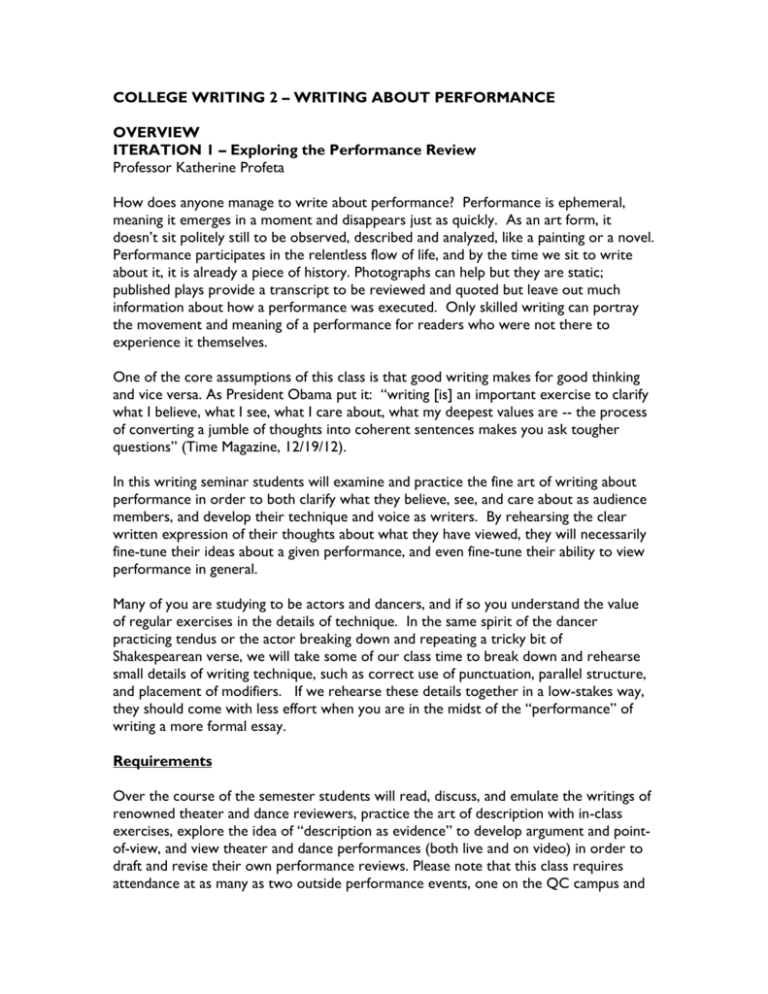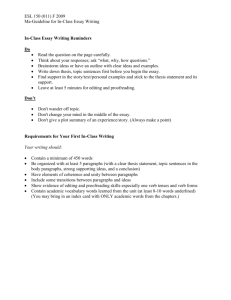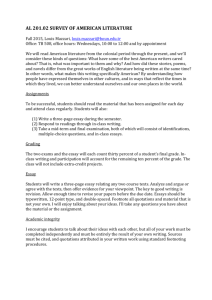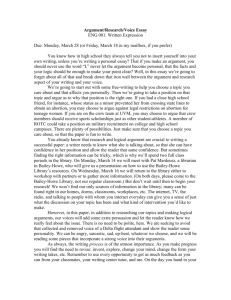Course Overview and Assignments
advertisement

COLLEGE WRITING 2 – WRITING ABOUT PERFORMANCE OVERVIEW ITERATION 1 – Exploring the Performance Review Professor Katherine Profeta How does anyone manage to write about performance? Performance is ephemeral, meaning it emerges in a moment and disappears just as quickly. As an art form, it doesn’t sit politely still to be observed, described and analyzed, like a painting or a novel. Performance participates in the relentless flow of life, and by the time we sit to write about it, it is already a piece of history. Photographs can help but they are static; published plays provide a transcript to be reviewed and quoted but leave out much information about how a performance was executed. Only skilled writing can portray the movement and meaning of a performance for readers who were not there to experience it themselves. One of the core assumptions of this class is that good writing makes for good thinking and vice versa. As President Obama put it: “writing [is] an important exercise to clarify what I believe, what I see, what I care about, what my deepest values are -- the process of converting a jumble of thoughts into coherent sentences makes you ask tougher questions” (Time Magazine, 12/19/12). In this writing seminar students will examine and practice the fine art of writing about performance in order to both clarify what they believe, see, and care about as audience members, and develop their technique and voice as writers. By rehearsing the clear written expression of their thoughts about what they have viewed, they will necessarily fine-tune their ideas about a given performance, and even fine-tune their ability to view performance in general. Many of you are studying to be actors and dancers, and if so you understand the value of regular exercises in the details of technique. In the same spirit of the dancer practicing tendus or the actor breaking down and repeating a tricky bit of Shakespearean verse, we will take some of our class time to break down and rehearse small details of writing technique, such as correct use of punctuation, parallel structure, and placement of modifiers. If we rehearse these details together in a low-stakes way, they should come with less effort when you are in the midst of the “performance” of writing a more formal essay. Requirements Over the course of the semester students will read, discuss, and emulate the writings of renowned theater and dance reviewers, practice the art of description with in-class exercises, explore the idea of “description as evidence” to develop argument and pointof-view, and view theater and dance performances (both live and on video) in order to draft and revise their own performance reviews. Please note that this class requires attendance at as many as two outside performance events, one on the QC campus and one elsewhere at a professional venue, and two video screenings, one on the QC campus and one at the New York Public Library for the Arts. Overview of Assignments Essay #1 – a 4-6 page review essay of a dance performance viewed on video (eg: Martha Graham’s Night Journey) Assignment Using the principle of “description-as-evidence” as elucidated in the Jowitt article, characterize the experience of watching this performance for a reader who has not seen it him/herself. Try your best to conjure it in his/her “mind’s eye,” and in a manner that provides evidence for your argument concerning the performance’s power and worth. Audience The intelligent general readers of publications such as The New York Times, The New Yorker, New York Magazine (no geographical bias here!) who are likely to be interested in this choreographer’s work but have not seen the performance in question. Versions submitted Two, first draft and final, with in-class peer review after first draft Learning Goals Development of descriptive writing skills with emphasis on choice nouns and active verbs over copious modifiers Use of description-as-evidence Building an argument up from a personal reaction. Pre-draft assignments In-class exercise on “Elements of the Academic Essay” (Harvey) as relevant to the performance review form In-class exercise on descriptive writing, in response to a 5 min live guest dance/movement performance In-class exercise on note-taking during performance, in response to a 5 min video clip In-class exercise on using active verbs In-class exercise marking up professional reviews to locate the components of “description/analysis/interpretation/evaluation” (Feldman via Oliver) In-class exercise on moving “Beyond Description” to “description-as-evidence” Blog assignment on descriptive writing, in response to physical action witnessed in everyday life Blog assignment on “my strongest reaction to this piece.” Source materials Contemporary professional reviews sourced in the recent weeks of New York Times, The Village Voice, The New Yorker and New York Magazine. Graham, Martha. Night Journey [video]. Harvey, Gordon. “Elements of the Academic Essay.” Harvard University, date unknown. Jowitt, Deborah. “Beyond Description: Writing Beneath the Surface.” In Moving History/Dancing Cultures: A Dance History Reader. Middletown: Wesleyan U Press, 2001. Oliver, Wendy R. “Chapter 4: Dance Critiques” in Writing About Dance. Champaign, IL: Human Kinetics, 2010. Essay #2 – a 4-6 page review essay of a theater performance (either seen live at Queens College or on video; if the latter e.g. Anna Deavere Smith’s Fires in the Mirror) Assignment Continuing to practice your skills of description and argument, and your your new skill of paraphrase, please craft a review that takes a decisive stance about the power and worth of this performance, and uses a lede and structure that supports that stance. Remember that in evaluating worth you will need to be explicit about the criteria you use to determine value – it is not enough just to say something is “good” and expect us to agree with you. Audience Same as Essay #1 Versions submitted Two, first draft and final, with peer review after first draft. Instructor may, as a surprise revelation after first draft, ask the students to edit the first draft down to only 5 paragraphs for the final version (or define the reduction by word count instead of paragraph), making the point that editing to do more with less is a desirable skill to cultivate. Instructor may also provide an essay about the work by the artist (eg Anna Deveare Smith) after the first draft, encouraging the students to incorporate an acknowledgment of Smith’s intentions for the performance into their final review. Learning Goals Continuing to build argument from description-as-evidence Practicing the new skill of paraphrase Crafting a lede sentence which draws in the reader and supports an argument Eschewing chronological structure and finding the structure to fit the argument Editing for concision (in the second draft) Pre-draft assignments In-class exercise on descriptive writing and paraphrase, in response to a 5 min live guest monologue In-class exercise on “lede” sentence, using sample professional reviews In-class exercise on anticipating counterarguments Blog assignment on “my strongest reaction to this piece.” Blog assignment on Novick’s “The Critical Instinct” Source materials Contemporary professional reviews sourced in the recent weeks of New York Times, The Village Voice, The New Yorker and New York Magazine. Novick, Julius. “The Critical Instinct.” In The American Theatre Reader: Essays and Conversations from American Theatre Magazine. New York: Theatre Communcations Group, 2009. Rich, Frank. Hot Seat: Theatre Criticism for the New York Times, 1980-1993. New York: Random House, 1998. Smith, Anna Deavere. “Introduction.” Fires in the Mirror [published script], New York: Anchor Books, 1993. Smith, Anna Deavere. Fires in the Mirror [video]. Essay #3 – 5-8 comparative review essay of a professional performance seen live, read against a relevant other performance (by the same artist, or on a similar subject) as researched and viewed on video at the New York Public Library for the Performing Arts. Develop an argument that offers some new insight that you gained from watching these two performances together, and use description-as-evidence to show how the two pieces ‘speak’ to each other in meaningful ways. (Instructor will choose performances based on availability of affordable live performance at QC or in NYC that semester, and then give students one or more viable options of performances they could research and screen at the library.) Assignment Incorporating the skills we have rehearsed already this semester, and employing your new skill of rich comparison, craft a review essay that discusses performance A in light of performance B, using description-as-evidence to build an argument about how the two work relate, or “speak” to each other. Audience same as Essays #1 & #2 Versions submitted Two, first draft and final, with peer review after first draft. Learning goals Crafting a rich comparison; making use of the research resources of the New York Public Library; continuing to build argument from description-as-evidence and devising a lede and structure to support that argument. Pre-draft assignments In-class exercise on key words for rich comparisons In-class freewrites comparing two performance video clips (eg: excerpts of the same scene from two different productions of Chekhov’s The Seagull; excerpts of an early-career and later-career solo from choreographer Ralph Lemon). Class visit to the New York Public Library to learn how to access video resources in the Research division Two blog assignments on “my strongest reaction to this piece.” Source materials Chekhov, Anton. The Seagull. [video, x2] Lemon, Ralph. Solo from Folkdance and Tree. [video, x2] Live performance and selected NYPL video performances, TBD based on the available live performances this semester.






